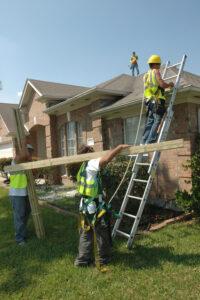Blue tarps that still cover hundreds of storm-damaged homes in Houston – including some houses battered by Hurricane Ike in 2008 – could finally be gone thanks to a new city program that’s promising to perform long-overdue roof repairs.

In the wake of Ike, which came ashore near Houston and caused $29 billion in damage, many of the thousands of homes damaged in the Houston-area were covered by the tarps.
Houston officials say two other programs have previously helped fix thousands of homes damaged by Ike or helped build new ones. But red tape and issues related to delinquent taxes and ownership questions have caused delays in repairing some homes that still have the blue tarps, said Tom McCasland, interim director of Houston’s Housing and Community Development Department.
“There’s been a lot of work replacing homes. But we wanted to really zero in on the homes that need a roof and where a roof will fix the long-term problems with the house. … With a new roof, the home can continue to be a place where it’s habitable, healthy, safe and affordable for the people to live,” McCasland said.
Houston Mayor Sylvester Turner, who took office this year, asked McCasland to tackle the blue tarp problem, and McCasland said his department worked to simplify things, streamlining an application process that once took up to 160 days down to a half-hour during a home visit.
“We can’t build a city of complete communities when so many of our citizens can’t count on the roof over their heads to keep them dry in a storm,” Turner said in a statement.
One of the Houston residents hoping to be helped by the new “Blue Tarp Program” is Margaret Gaines, who thought she no longer had to worry about her roof after it was repaired with help from the city following Ike. However, Gaines said shoddy repair work caused her roof to collapse again in August and come crashing down in her bedroom.
“I’m scared to sleep in here,” the 70-year-old Gaines said Friday as she stood in her bedroom, part of a blue tarp cascading down along the walls from where the ceiling was once located. “This is just so much. I come in here and I get so frustrated.”
The new program focuses on lower-income residents like Gaines who can’t afford to pay for the repairs. Many of the homes identified through aerial imagery as having blue tarps are located in some of Houston’s lower-income neighborhoods.
McCasland said preliminary indications are that about 200 homes could qualify for the program, which is not limited to roofs damaged during Ike. Homes that have more than $65,000 in overall damage will not qualify but homeowners will instead be directed to other programs focused on tearing down and replacing such homes.
On Friday, McCasland, along with two other department employees, knocked on the doors of blue-tarp-covered homes in the South Acres neighborhood in the southern part of the city. At one home, they helped a man fill out an application. At two other homes where nobody answered the door, they left flyers with program information.
McCasland said the quick turnaround to get people enrolled in the program and begin their repairs within two weeks is part of an effort to “overcome some suspicions that it’s one more government program that is not going to deliver.”
The Texas Organizing Project, a nonprofit that addresses social and economic issues, has been critical of delays in Houston to fix these homes. Mary Moreno, a spokeswoman for the group, said the long-overdue repairs speak to a broader issue of inner-city neglect.
“It’s not just with Hurricane Ike. The neglect has been going on longer. That’s why we want to keep fighting for investment” in these neighborhoods, she said.
Gaines, a retired school bus driver, said she’s hopeful she’ll qualify for the program.
“This is the only place that I have,” she said. “This is home.”
Was this article valuable?
Here are more articles you may enjoy.

 Losses Top $20 Billion in Asia Floods as Climate Risks Grow
Losses Top $20 Billion in Asia Floods as Climate Risks Grow  How Three New CMS Policies Impact Workers’ Comp Claims
How Three New CMS Policies Impact Workers’ Comp Claims  State Farm Sued Over Policies Backed by Distressed Insurer PHL
State Farm Sued Over Policies Backed by Distressed Insurer PHL  Standard Chartered Settles $2 Billion Iranian Sanction Suit in London
Standard Chartered Settles $2 Billion Iranian Sanction Suit in London 